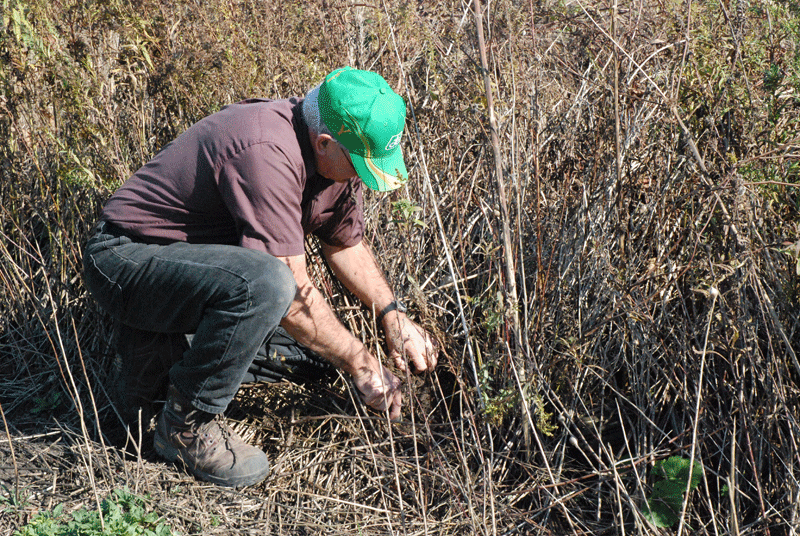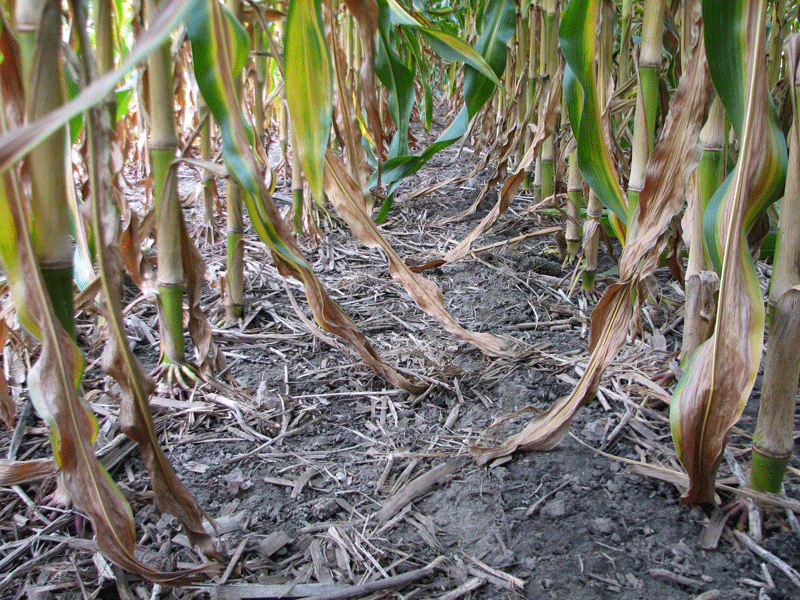Fence row farming
UNCOVERING THE SECRETS IN THE SOIL
DEAN GLENNEY PLANTS his corn and soybeans on exactly the same rows, drives on the same tracks, and never tills his fields. It’s a farming method he has used for nearly 20 years now; and it has given him corn yields averaging 275 bushels an acre (bu/ac) and soybeans averaging around 60 bu/ac. In 2012, Glenney’s highest corn yield was 301.88 bu/ac.

“It’s a lot of extra work to do,” says Glenney. “When I first started, I had to go by eye to keep on the same rows year after year. Now with auto steer and GPS mapping, it keeps track of it for me and it’s a lot easier to run the same passes.”
INTO THE WORMHOLE
Glenney, who farms 180 acres in Dunnville, Ontario, is trying to prevent any soil disturbance that would interfere with the worms in his fields. The only extra work he does is cut the corn stalks with a chopper in the spring to make it easier to plant the soybeans into it. “The worms will take the leaves from the corn and pull it down into the hole,” explains Glenney. “The more residue you have, the more worms you have. They like to come up to the surface and get it and drag it down. They can’t get it when it’s buried by a plow. If I started plowing this soil I would lose 100 bushels an acre.”
As the worms pull the corn leaves down into their holes, their movements are creating very porous soil. That allows roots to grow deeper, releases more nutrients and allows the soil to store water more effectively. The result, Glenney says, is a soil condition equivalent to the soil in a fence row every 30 inches across the farm.
“You just have to go and dig into your own fence row to see the quality of soil you could have,” says Glenney. “It took six or seven years before it started working for me, but after that I started to get a good yield response.”
When Dr. George Lazarovits is finished with his research, other farmers won’t have to wait that long to see their own yields increase. Lazarovits and Dr. Rafiq Islam, both scientists with A&L Biologicals’ Agroecology Research Services Centre in London, Ontario, are figuring out exactly why this method works; and he says more than just worms are at work in the soil.
SAMPLING THE SOIL
During the 2012 growing season, Lazarovits took samples from Glenney’s field and a neighbouring farm field where the same corn variety was planted but traditional tilling methods were used. He uprooted corn stalks during the season and collected the soil from their roots in order to conduct a chemical analysis and determine what kind of fertilizer was still remaining in the samples. Glenney uses dry fertilizer in between the twin rows, plus 28% nitrogen on either side of the twin rows. Half of the nitrogen is applied at planting; the other half is applied later on when the corn is 16 inches high.
PHOTO: WORMS COME UP TO THE SURFACE TO DRAG DOWN THE RESIDUE

“One of the things that pops up immediately in our analysis is that Mr. Glenney’s plants use up all of the fertilizer almost within 70 days after planting. So some way this plant is sucking up all of the nutrients, but we’re not sure why yet,” Lazarovits explains. “The other field still has quite a lot of fertilizer remaining even at the end of the season. It just doesn’t get used. One of the fundamental things that’s happening is in one field the root system must be more efficient in taking up the nutrients.”
Lazarovits believes the specific micro-organisms that have developed in Glenney’s soil are playing a role in the improved root system and in the growth of the corn plants. Similar to what scientists have discovered in sugar cane, he is studying the bacteria in the corn stalk to determine which ones are affecting growth.
“We’re finding huge numbers of bacteria inside corn plants; and the bacteria that are inside Mr. Glenney’s corn plants are completely different than the bacteria typically found in corn plants,” Lazarovits notes. “It’s the type that are different, and possibly the amount. The ones in Mr. Glenney’s plants are much more uniform, pure species. We have some idea of who is in there, but we’ve only been working on this for a few months and nothing has been proven yet.”
Lazarovits believes this microbiological difference is related to the fact that Glenney’s fields have not been disturbed for nearly two decades. “Over this long period of non-disturbance, he has built up an ecosystem that is now uniquely adapted to the corn-soybean system he has developed. And that’s what we hope to verify during this 18 month study.”
MICROBE MANAGEMENT
According to Lazarovits, it’s important to note that what has been created is a healthy soil environment for a specific crop; and he’s even calling into question the need to rotate corn with soybeans to see the same high yielding results. His research will continue this summer with the goal of identifying the important microbes that are responsible for enriching the soil and he wants to confirm the biologic information for who is living on the roots and who is living inside the stem of the corn plants.
These microbes could potentially be put on corn seeds in order to selectively colonize the plants. This would give other farmers the same benefits without the length of time it took Glenney to build up his soil’s ecosystem.
“The goodness from the soil is coming from the microbes that inhabit it,” says Lazarovits. “We have to figure out how to exploit these microorganisms to produce better crops.”
HIGH YIELDS
Dean Glenney’s ‘fence row farming’ suffered a set-back during the 2012 growing season, but he still achieved impressive results. Mushroom compost was spread on his fields without realizing the negative effect the salt content in the compost would have.
The soybeans had to be replanted on June 2, where the mushroom compost was spread. Glenney used the headland as a test strip since it was the only place in the test plots that did not have compost added to it. Dunnville, Ontario received 63.5 millimetres (2.5 inches) of rain from planting to August 1, and irrigation was done in July.
Soybeans
• Headland – no compost, no irrigation, not in corn residue – 72 bu.
• Replanted – compost, no irrigation, not in corn residue – 47 bu.
• Replanted – compost, 3″ irrigation, in corn residue – 57 bu.
• Not replanted – no compost, 1″ irrigation, in corn residue – 57 bu.
Corn
The corn was not affected as badly by the salt. However, Glenney reported there appeared to be less worm activity and a lot of variability in yield between adjacent plots.
• Highest Yield – compost, 3″ irrigation – 301.88 bu.
• 2nd Highest Yield – compost, no irrigation – 294.63 bu.
• Average – compost, 3″ irrigation – 283 bu.
• Average – compost, no irrigation – 275 bu.
• Full strip across the farm – 1.5 acres, no compost, 1″ irrigation – 248.97 bu.
Funding for this project has been provided by Grain Farmers of Ontario. Funding is also provided in part by Agriculture and Agri-Food Canada through the Canadian Agricultural Adaptation Program (CAAP). In Ontario, this program is delivered by the Agricultural Adaptation Council. •






















